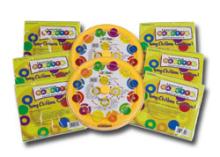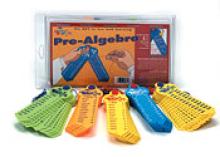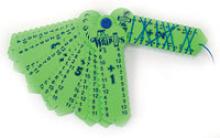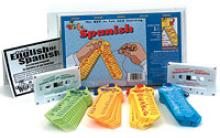No name
Learning Latin with Grandpa Carmellus
Program consists of an audio tape, a reader and an activity book (approximately 30 pages each) This home produced conversational Latin program is designed for young children. Your pre-Latin students from Kindergarten up may enjoy getting a taste of the language, especially if their older siblings are studying Latin. The program consists of two softcover books (the binding leaves something to be desired) and an audio tape.
The reader contains the full text of the audio tape so that the child may read along with the tape (and probably absorb the lesson more fully in this manner). Grandma Maria (who is helping out Grandpa Carmelus in the American version) takes us back to Ancient Rome with the help of "Sprig", the magic kangaroo. Each lesson introduces some basic Latin words and gives some practice using them in a sentence or other conversational context (such as counting). Children will learn how to say Hello and Goodbye, count various items from one to ten in Latin, and some simple sentences involving places, animals and everyday activities.
The activity book includes some fun Latin practice involving matching words, unscrambling and finding missing letters. Both books include lots of clip-art type illustrations which can be colored in by your young student.
Catholic content is found throughout the program - particularly in the Saint stories and the use of Catholic names (such as Jacinta - my 6 year old of that name was particularly delighted!)
For more information including how to order this program, click here. Note: The price for the program, noted on the website, is $16 plus $9 shipping - Australian Dollars. According to the Universal Currency Converter, this is equivalent to $10.18 plus $5.73 shipping - American Dollars. So the total cost, including shipping from Australia is $15.90
Learning Palette Mathematics
Learning Wrap-Ups, plastic palette and colored discs with self-correcting card sets (This review is based on use of the first and third grade sets).
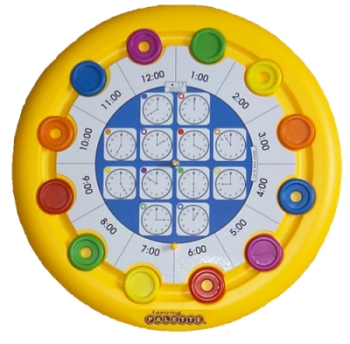 This clever learning tool for young children features an almost 12 inch diameter "palette" which holds a double-sided learning card and 12 different colored discs. A clear plastic lid is included. I have been very impressed with how these palettes hold up under a lot of use (and occasional abuse from babies and toddlers). Each card has pictorial equations or problems on one side. The child matches the correct color/shape disc with the answer he chooses. When finished placing all twelve discs, he can turn the card over and correct the answers himself.
This clever learning tool for young children features an almost 12 inch diameter "palette" which holds a double-sided learning card and 12 different colored discs. A clear plastic lid is included. I have been very impressed with how these palettes hold up under a lot of use (and occasional abuse from babies and toddlers). Each card has pictorial equations or problems on one side. The child matches the correct color/shape disc with the answer he chooses. When finished placing all twelve discs, he can turn the card over and correct the answers himself.
Cards are purchased in sets of 12 (a total of 144 problems since there are 12 problems per page). Math sets are available for first through third grade. There are six card sets available for each of these three grades:
Three sets of Numeration Cards: The numeration sets cover all kinds of basic math operations with an appropriate level of challenge and content.
One set of Algebra Concept Cards: First grade algebra card "challenges" include recognizing missing numbers and finding missing shapes. The third grade cards involve solving for the unknown in addition subtraction, multiplication and division.
One set of Geometry and Measurement Cards: First grade cards cover shape names, volume, calendars, telling time and reading thermometers. The third grade set covers includes problems regarding perimeter, area, geometric forms and terms, simple graphing and units of measurement.
One set of Probability and Statistics Cards: These cards cover topics like "more and less likely" and tallying in the first grade set. The third grade set provides practice in the relationship between fractions and probability, determining the likelihood of an event and using the data from charts to draw conclusions.
I am very impressed with the level of challenge and variety of topics covered at appropriate age-levels (they meet the National Council of Teachers of Mathematics standards). We have found these particularly nice because they offer mental stimulation while taking a break from writing-skills (which can be very taxing on children in the early grades). For example, we used these with my third grade son last year as a supplement to MCP 3rd Grade Math. Some days he would just do Learning Palettes for his Math assignment. (In addition, I had him spend some time doing mazes and other fine-motor skill building activities.) He didn't do every page of the MCP book - instead I let him test out of some of the chapters (he had to achieve a very good score in order to skip the chapter - naturally we had to discuss some concepts as they came up on the Learning Palettes as well).
Investing in the entire line of Learning Palettes can be rather expensive. The Palette itself is about $15 and each card set is $10 (you can buy grade-level groupings of six sets for a little less). I found this investment to be quite worthwhile since the product is non-consumable (and quite sturdy). The material is very straightforward and well thought-out.
Learning Styles Test and Evaluation
Truly a unique offering, the Learning Styles assessment from Mercy Academy provides a wonderful opportunity for a homeschooling parent to learn how to better teach their child(ren). Understanding the best way in which a child learns, as well as learning how to strengthen their weaker areas, will make each day's lessons more productive and less frustrating. You will not necessarily need to purchase new curriculum in each subject area; instead, you will learn how to use any materials more effectively.
The Learning Styles Test is available year-round. Each of the test questions is short and easy to answer, requiring only a click of the mouse. You may need to read the questions to the very youngest students. Although the test is several online pages long, it can be completed in about thirty minutes. If you are interrupted, you can resume the testing at a later time. Results are immediately available.
These results are the gold nuggets! The student responses to seeminly-simple questions provide a rich, personalized analysis that requires careful attention. In fact, the author recommends that you read it several times and at several different levels. This in-depth document includes an overview of the student's learning style, instructions for understanding and using the test results effectively, and a multi-page, detailed description of this type of learner based on an analysis of five different identifying categories. Following this are "Key Points to Remember", which summarize the description. Next, very specific teaching techniques and teaching materials advice, resulting from extensive research and testing, are included. These recommendations include curricular materials by name with purchasing information, advice as to where and how the student should be studying, as well as specific things to avoid.
I tested several of my children, and I was astounded at the variations amongst them. I had naively assumed that there would be more overlap between them, but the resulting descriptions fit each child very closely. Even after homeschooling for many, many years, I found that I had a great deal to learn! This testing process saved me months of effort and many, many dollars in curricular purchases that would not be best suited for the particular child who was tested. I also appreciated the recommendations for which children especially need to have regular outside-the-home opportunities as well as those for whom distractions are a problem. My older children read and studied their own assessments, finding the descriptions very accurate. I believe that these will be very useful to them as they consider potential careers and college choices. This was a very worthwhile experience for our entire family.
Learning Styles Test and Evaluation
I just had three of my children (grades 1, 3 and 6) tested for learning styles through Mercy Academy. The test is quite simple and has to do with likes, dislikes, ways of interacting and how they think about problems. Older children can take the test on their own, while younger ones might need a little supervision. I was very impressed with the thoroughness and usefulness of the analysis and evaluation given.
Each of my children received a unique 7-10 page analysis based on five different "preferences and modes of learning":
- General mode of interacting with the world
- Method of taking in information and viewing the world
- Center of influence in decision-making
- Method of organizing information about the world
- Preference for processing information
The analysis includes: main personality characteristics, tips for the best environment for them to study in, detailed guidance on modes of presentation and potential intellectual/moral pitfalls, ideas for handling problems they have with learning, and important skill areas to develop. This written analysis is followed by lists of "Key Points to Remember", types of materials that work best, things to avoid and sample curriculum recommendations (with an emphasis on Catholic materials where possible!).
Although any one of my children individually would have benefitted greatly from my application of the results of this test, it was particularly fascinating to have three children tested and compare the results. The entire report is highly customized for each child according to the five key factors listed above. The accuracy of the points and ideas in each analysis astounded me. While I was vaguely aware of the differences between auditory and visual learners, reading these results opened a whole new world and a much better sense of the big picture of what my children need and how I can best help them. (I even learned a bit about myself in various pieces by seeing my own traits in my children!) While some pieces of my children's learning styles were merely expanded and reinforced, there were some ideas that were new to me (like different needs in terms of study environment) that we've been implementing with great success. Some of the types of details that have come up include: need for discussion time with parents, balance between textbooks and more unconventional methods of learning, competition, and pointers on avoiding distraction and frustration for each child.
Reading these evaluations and beginning the process of implementation has been both challenging and encouraging at the same time. Challenging because I can see a number of the pitfalls and difficult areas more clearly. Encouraging because I more fully understand that unusual traits aren't necessarily negative or abnormal, but can be worked with successfully and even beneficial when fully appreciated.
The test and evaluations were put together by a Catholic homeschool mother of 6 with a PhD in Psychology and many years of experience in homeschooling her own children and counseling other homeschool families.
Learning to Appreciate Art
Used with the Catholic Heritage Curricula Fourth Grade Lesson Plans
This lovely, well-written art resource offers an excellent introduction to composition, perspective and form; various kinds of art (mosaic, fresco, sculpture, etc.); a brief history of early art (including cave paintings, Egyptian and Greek art); and a detailed account of a number of major artists of the Renaissance and pre-Renaissance (Giotto, Fra Angelico, Botticelli, Leonardo da Vinci, Michelangelo and Raphael). Through art reproductions, simple line drawings and engaging text, the child will be drawn into a surprisingly in-depth way of looking at a work of art. I was especially impressed by the "Appreciating Art" segments that follow the works of some of the artists. These give step-by-step ideas, questions and hints to get more out of each picture and learn to appreciate the strengths and uniquenesses of each artist.
The individual art reproductions - representing the Master artists listed above as well as examples of different historical periods and types of art, are intended to be placed in the book by the student (there is a miniature black and white reproduction of each piece so the task is quite easy to do). This type of active involvement helps a child to take the material "for their very own" in a way that simply reading and looking at a book doesn't always accomplish. The Catholic material is interesting and well-connected to the subject - especially in a world where most children's art materials are devoid of religious or even classical subjects.
What our family did was to move this appendix into its own binder. We laminated the art reproductions and keep them in the back of the binder to allow our children to match them up with the appropriate spot over and over again (a Montessori sort of thing to do). It also allows older and younger siblings to enjoy this resource. This is a really lovely resource - one of the nicest materials I've come across in awhile. I learned some new things from the text too. Do you know why Leonardo da Vinci's Last Supper was so faded in comparison with other works from the same general time period (like the Sistine Chapel)? Or why the very famous pair of thoughtful angel cherubs were placed at the bottom of the Sistine Madonna by Raphael? Well, I won't tell you, but you'll find these and lots of other interesting tidbits in this very nice and highly recommended text.
Learning Wrap-Ups for Pre-Algebra: Introductory Kit
Each of five sets in this kit have 10 plastic key-shaped cards that fan-out at a pivot point. A sturdy string attached to the pivot point is pulled through a hole in the card. The student then wraps the string from the first problem to the answer, around the back of the card to the next problem, etc. After completing the card, you turn the card over. If the string matches with the lines on the back, all the answers are correct.
The five sets drill the following materials:
Addition & Subtraction of Positive and Negative Numbers Sample problem: (-9)-(-2)=t
Multiplication & Division of Positive and Negative Numbers Sample problem: (-7)x(-12)=p
Solving for the Unknown (Working with Variables) Sample problem: (-42)-z=(-3)
Understanding Algebraic Expressions Sample problem: Given x=7, evaluate 8x-7
Mental Math, Prime Factors, Perfect Squares, Square Roots, Formulas for Area, Perimeter and Volume Sample problem: Find the square root of 289
Our family has enjoyed the Learning Wrap-ups as a nice way to drill facts. I'm impressed with the thought that has gone into the equations. My 6th grade daughter has found this set a little challenging (more appropriate for 7th and 8th grade), but a welcome change from her textbook.
Learning Wrap-Ups: Basic Math Introductory Kit
These colorful key-shaped plastic flash cards allow students to practice basic Math skills by wrapping a string around the ribbed edges of each card to identify the correct answer. (Cards are attached together on a pivot point in groupings of 10 cards organized by operation.) The cards are cleverly self-correcting – when the child finishes each card, they simply flip it over; when all answers are correct, the string will match the diagram on the back of the card. The basic operations sets are simple equations where you match the equation to the correct answer. For the fractions set, you are matching equivalent fractions – pictures to fractions, pictures to pictures and fractions to fractions – plus a few simple equations which involve adding and subtracting fractions.
We have found this to be a great way for our children to practice their basic math facts. They are colorful and appealing and offer a welcome change from regular book-work.
Please note when ordering this product that there are many varieties of this product – some including CDs or workbooks, or even large classroom size sets. The set reviewed here retails for about $45-$50 (in 2024) and contains 5 flash-card sets – Addition, Subtraction, Multiplication, Division and Fractions.
Also see the Learning Wrap Ups website for more details and an animated demo.
Another reviewer (Suchi Myjak) notes: One of my sons is a highly visual learner, so much so that he managed to memorize the patterns that the strings made on the fronts of the keys. He could "do" the wrap-ups incredibly fast, but was not actually learning the facts. Parents may want to occasionally check the student's math facts in some other way to ensure that they are really getting learning. The wrap-ups did work well for my other children.
Learning Wrap-Ups: Spanish Introductory Kit
Our family has been enjoying Learning Wrap-Ups in a variety of subjects to drill and practice basic concepts. Each set consists of ten key-shaped plastic flash cards attached at a pivot-point with a string to wrap back and forth from question to answer. After finishing each key, simply look at the back to be sure the string matches up with the self-correcting answer key. I love how my children can study independently with these sets AND they can be used over and over again. They are sturdier and more self-contained than ordinary flash-cards (and don't get lost under the couches!). Learning Wrap-Ups may be purchased one set at a time or in money-saving multi-set kits.
The Spanish Introductory Kit includes four flashcard sets:
Learning Words: Each of these cards involves matching pictures to Spanish words. Subjects covered are: parts of the body, school words, clothing, food, animals, family members, household objects, outdoors and transportation.
Talking Basics: Match numerals, symbols and pictures to Spanish words. Some are in the format of simple fill-in-the-blank sentences. Subjects covered: counting, months of the year, action words, miscellaneous objects, more parts of the body, opposites, directional words, holidays and week days, and telling time.
Making Statements: This set uses simple fill-in-the-blank sentences to practice vocabulary in the following subject areas: fruit, things you can read about (also practices plural endings), miscellaneous objects (while practicing using "an" before vowel words and using "a" before consonant words"), things we wear, objects in a living room, more action words, money and stating a need.
Asking Questions: Topics include: Observing zoo animals, tools and equipment, occupations, places, science class materials, vegetables, miscellaneous nouns, bathroom items, kitchen items, and shopping.
The pocket-sized 31 page booklet provides the English translations for each of the Learning Wrap-Ups (the Wrap-Ups themselves do not use any English). We've found this to be a great place to start studying (particularly when I'm doing things with my children in a group). My children line up and enjoy acting out the Spanish words while they're learning them. The booklet is really handy for oral quizzing as well. The children go back to the Learning Wrap-Ups for independent study. The set also includes two audio tapes. (We haven't really used these yet as we tend to do our oral work together. I'm sure it will be handy for further independent study at some point.)
Kit includes: 4 sets of plastic flash cards, one teaching booklet and two audio tapes
This product was donated for review by Learning Wrap-Ups Inc.
Legends of Saints and Beasts
What a lovely book! Legends of Saints and Beasts retells the stories of four saints and their associations with animals. Included in this beautiful hardbound collection are the stories of Saint Jerome and the lion, Saint Roch and his dog, Saint Francis and the Wolf, and Saint Macarius and the hyena. The text is written in a decorative style in which capital letters are colored in a pattern reminiscent of medieval texts, and the colorful line-drawn illustrations are charming. The choice of vocabulary also has an old-world feeling to it that adds a great deal to the stories' style but puts the independent reading level probably from fourth grade and up. The final three pages of the book contain more detailed background information about the lives of these saints, making this an even more special book. Highly recommended!
Copyrights 1954/2000

